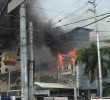Joel Basiao, a driver of a passenger jeepney plying Davao city’s route of barangay Puan to Magsaysay Park, said he lost as much as P200 on Thursday for joining the nationwide transport strike.
But he said it was just about the same amount that jeepney drivers like him have been losing every day since the beginning of the year because of the unabated increase in the prices of oil.
From only about P30 per liter in January this year, oil prices increased 16 times in the last 11 months to P38 per liter this month.
At the prevailing price, Basiao needed P1,140 a day to pay for the average of 30 liters of gasoline he consumed every day. The amount is 26.66 per cent more than the P900 he used to pay a day for the same amount of gasoline he consumed in January.

On Strike. Students out on the streets show support of the transport strike. (davaotoday.com photo by Barry Ohaylan)
“This means, passenger jeepney drivers are spending more than P200 (or P240, in his case, to be precise) a day on gas alone,” Basiao said. “This is eating up the jeepney driver’s take home income,” Basiao said.
He said he feels lucky enough these days if he can bring home P200 to his family as earnings at the end of the day. Driving a jeepney from six in the morning to nine in the evening, Basiao practically works 15 hours a day.
“Losing P200 to join the strike is a very small sacrifice we had to make,” Basiao said.
He said there’s no other better way to negotiate for the oil price. “We are only drivers, we are not lawmakers,” Basiao said. “This is the best way we can send a strong message to the government.”
Unlike in other parts of the country, where the transport strike fizzled out in the second half of Thursday, protest organizers here declared the transport strike a success even before the afternoon was over.

No Choice. Jeepney driver Joel Basiao(davaotoday.com photo by Barry Ohaylan)
Very few public utility jeepneys (PUJs) were seen plying major thoroughfares. Private cars and taxis made up most of the running vehicles on the streets.
San Pedro Street, which used to be heavily congested during rush hours, was almost bare. Vehicles flowed smoothly into Bankerohan bridge, considered one of the city’s bottlenecks, and were hardly seen on the chokepoints of Ponciano and San Pedro streets.
The coalition of transport groups that organized the strike declared a 95 per cent paralysis of the city’s transport system, although the Traffic Management Center (TMC) said the strike only affected 70 per cent.
Of the 6, 685 passenger jeepneys plying over a hundred routes in the city, barely 500 passenger jeepneys were running during the strike, according to the Transport of Southern Mindanao for Solidarity, Independence and Nationalism (Transmission), an affiliate with the nationwide transport group, Pagkakaisa ng mga Samahan ng Tsuper at Opereytor Nationwide (Piston).
Major universities, like the Ateneo de Davao University, called off classes as early as eight in the morning when teachers observed that students who came were not even one-third of the class.










